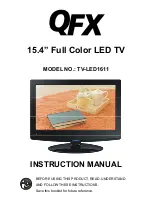
31
Symptoms(continued)
Symptom
Point to check
The temperature of the display panel surface is
warm.
The LCD display panel works by lighting phosphors. In some cases, this
may cause the temperature of the panel surface to increase. Please note
that this is not a malfunction.
Points that do not light, points with brightness
different from that of the periphery, points with
color different from that of the periphery, etc.
High-precision technology is used to manufacture the LCD display panel,
However over the life of the LCD panel, a few pixel elements may fail.
This is not to be considered a defect in the panel.
Coarse horizontal stripes appear in FULL display.
Adjusting the Clock Phase will reduce the horizontal stripes. (RGB input)
The screen flickers in the form of horizontal lines
oscillating up and down.
(PC INPUT MODE only)
If the frequency from the computer is below 85Hz, try a higher frequency
(to a maximum limit of 85Hz). There may be a slight attenuation of the
current image.
The top surface of the monitor heats up.
When used for long periods of time, the top surface of the monitor may
heat up. This is not a malfunction.
Text characters are displayed with varying
thickness.
The thickness of characters and lines may vary when images with a
vertical resolution greater than 720 lines are displayed; however this is
not a malfunction.
The display does not seem bright enough.
The ambient temperature of the monitor may be low. Ambient temperatures
less than about 15° degrees, may cause lower luminance.
The panel protection circuit automatically lowers the luminance, and is
not a malfunction. The luminance will be restored when power is turned
on for a while.
The display does not seem bright enough. (RGB
input)
The setup-frequency setting in RGB input may be set to PC mode. When set
to PC mode, the luminance is lowered by about 10% than when set as Movie
mode. This is not a malfunction. If you do not mind flicker on the display,
please switch to Movie mode.
Troubleshooting
continued
















































